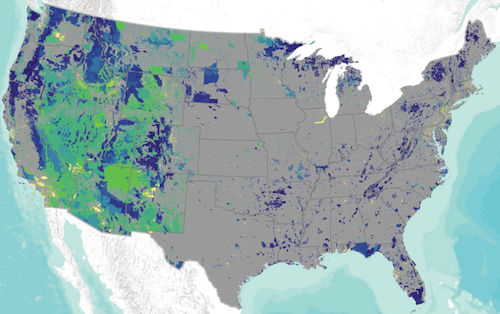Noise sprawl threatens protected areas, critical habitats
Effects of Noise on Wildlife, Science, Wildlands Add commentsLay summary of:
Noise pollution is pervasive in U.S. protected areas. Rachel T. Buxton, Megan F. McKenna, Daniel Mennitt, Kurt Fristrup, Kevin Crooks, Lisa Angeloni and George Wittemyer (May 4, 2017). Science 356 (6337), 531-533. [doi: 10.1126/science.aah4783] Online access (subscription)
Ongoing data analysis by researchers from the National Park Service and Colorado State University is revealing an increasingly detailed picture of the sprawling impact of human noise in protected areas around the United States. The most recent paper from this groundbreaking team digs into the sound models to offer a better sense of how extensive the issue is, and highlights the promise of focusing conservation efforts on preserving areas where the human noise footprint remains small.
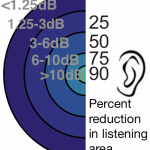
The researchers zero in on two key thresholds of noise: 3dB above the natural ambient sound, which marks a doubling of noise levels (causing a 50% reduction in the area over which sounds can be heard), and 10dB of excess noise, which is a 10-fold increase, leading to a 90% reduction in listening area. As the authors note, these are “levels known to interfere with human visitor experience and disrupt wildlife behavior, fitness, and community composition.”
The new maps include all protected areas in the US: federal, state, and local. Not surprisingly, the “natural” areas near cities tend to be very loud (yellow on the maps below, up to 30dB of additional human noise).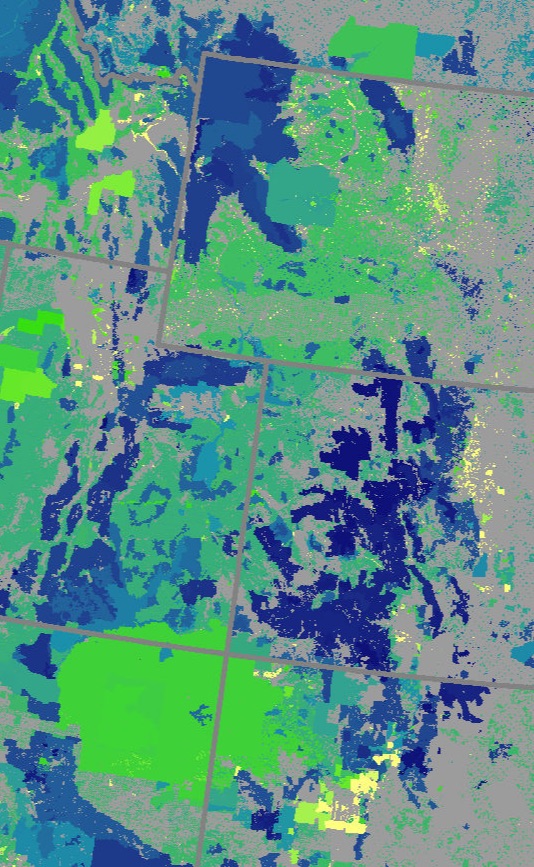 In these maps, only the two darkest shades of blue represent relatively healthy soundscapes; once the blue tips toward teal or aqua, we’re over 3dB and the acoustic habitat is significantly degraded. And all those shades of green are 10dB or more, marking territory where human noise is often dominant (in the west, this includes lots of remote, open areas where road noise travels far and the natural ambient level is very low).
In these maps, only the two darkest shades of blue represent relatively healthy soundscapes; once the blue tips toward teal or aqua, we’re over 3dB and the acoustic habitat is significantly degraded. And all those shades of green are 10dB or more, marking territory where human noise is often dominant (in the west, this includes lots of remote, open areas where road noise travels far and the natural ambient level is very low).
It’s important to note that these figures are median values for designated parcels of protected land; for example, that sprawl of green in the lower left is the Navajo Nation and Hopi Reservation, with squiggles of teal blue in a couple of National Monuments where fewer roads and less human activity keeps the median level a bit lower. The key thing to remember is that in any particular designated area, there will be zones with much less noise impact, and ones with much more.
21% of the protected areas in the US experience median noise levels of 10dB or more above the natural ambient; 63% have human-generated noise of 3dB or more. But when we break that out and look at trends within the protected landscapes as a whole, we find that the numbers look much better: only 1.2% of the protected acreage is exposed to median noise of 10dB or more, and just 34% has 3dB or more—meaning that 66% of the land area retains at least half of its natural listening area. This provides a big opening for targeted conservation work; I am especially interested in getting more detailed information on those rare areas where the human noise footprint is under 1.25dB; we need to insure that these remaining pockets of healthy acoustic habitat are protected from new noise impacts.
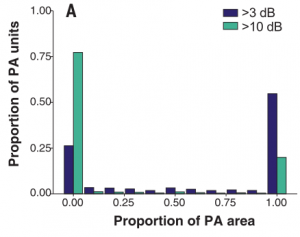 Interestingly, protected areas in the east, at least those outside the urban cores, are more apt to remain relatively quiet (see full map at the end of this post). Indeed, one of the key findings was that there is not that much area with noise between 3 and 10 dB—the national map doesn’t include all that much in the lighter shades of blue; most protected areas are either relatively free of human noise, or quite overrun with it. This graph gives a visual sense of the pattern: 75% of Protected Area units have no land at 10dB or more; 25% are entirely under 3dB. Meanwhile, at the other extreme, over half the units are saturated with 3dB or more, and for nearly a quarter, 100% of the protected land experiences 10dB or more of excess noise.
Interestingly, protected areas in the east, at least those outside the urban cores, are more apt to remain relatively quiet (see full map at the end of this post). Indeed, one of the key findings was that there is not that much area with noise between 3 and 10 dB—the national map doesn’t include all that much in the lighter shades of blue; most protected areas are either relatively free of human noise, or quite overrun with it. This graph gives a visual sense of the pattern: 75% of Protected Area units have no land at 10dB or more; 25% are entirely under 3dB. Meanwhile, at the other extreme, over half the units are saturated with 3dB or more, and for nearly a quarter, 100% of the protected land experiences 10dB or more of excess noise.
For another layer of good news/bad news, the researchers broke out all the designated Critical Habitat for endangered species. The bad news comes on the species level: over half the species are hanging on in designated critical habitats where our noise is 3dB or more, and 14% are faced with 10dB or more in their critical habitats. Note that this includes many species that are not directly affected by noise, including plants and invertebrates; they are included here because there is an array of evidence that the success of such species can be indirectly influenced by auditory species that they interact with (e.g., hosts, seed dispersal, and other co-evolutionary relationships).
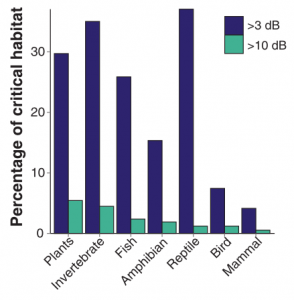 The good news comes when we pull back again and look at the total land area in designated critical habitats: in critical habitats for birds and mammals, less than 10% of the land area has even 3dB of noise, meaning that over 90% remains relatively quiet. For reptiles, who face the most noise, still 65% of critical habitat remains only slightly degraded by noise.
The good news comes when we pull back again and look at the total land area in designated critical habitats: in critical habitats for birds and mammals, less than 10% of the land area has even 3dB of noise, meaning that over 90% remains relatively quiet. For reptiles, who face the most noise, still 65% of critical habitat remains only slightly degraded by noise.
This offers a clear conservation opportunity. It is long past time to add acoustic considerations to assessment of the impact of new human activities in designated Critical Habitats, and indeed in any protected areas that remain relatively quiet. This will both benefit the health of natural communities and provide richer recreational opportunities for humans seeking refuge from our increasingly urbanized lives. A larger “acoustic horizon,” free of background noise from roads or industry, allows us to escape the enclosed spaces of our homes, vehicles, and streets, and become part of a wider, embracing landscape, offering much-needed emotional, mental, and spiritual restoration. And for the wild denizens of these protected lands, while they may not hear our noise quite the same as we do (and so their listening areas may be diminished differently than ours), there is ample evidence that both behavior and physiological stress levels are affected by chronic and transient human noise.
As human development continues to expand in and around existing protected areas, we need to take special care to preserve the remaining healthy acoustic habitats. I am especially looking forward to seeing an inventory of the protected area units where human noise is below 3dB, and especially those that are the darkest blue on these maps, representing those rare areas where the acoustic habitat remains close to its natural conditions, with no more than a 25% reduction in listening area. These are the places where a bit of extra attention now could pay dividends for decades to come.
As you may recall, this kind of bigger-picture assessment has begun to occur in relation to ocean noise; recent research has assessed the acoustic quality of existing critical habitat for several cetacean species, and has identified “opportunity sites” where noise is low and animal density high. At last year’s Ecoacoustics Congress, I summarized these important new directions in a presentation entitled Saving High-quality Acoustic Habitat, which included some of the earlier work from the research team that wrote the paper we’re discussing here.
The authors conclude their current paper with a powerful call to action:
Despite the expansion of the Protected Area (PA) network in the past few decades, biodiversity has continued to decline, emphasizing the importance of identifying factors that influence PA effectiveness. … Given the widespread distribution of anthropogenic noise and extensive research documenting its negative impacts, noise pollution merits consideration in combination with other major threats when assessing PA effectiveness, management of endangered species, and enhancing human experience.
Other than the soundscape management of the U.S. National Park Service, PA legislation does not include policies for the monitoring or management of anthropogenic noise. This is a conspicuous missed opportunity, as techniques to manage noise pollution are readily available and noise management could improve ecological resilience and enhance quality of habitats facing multiple threats.
I couldn’t agree more! Here’s to the promise of building on the initial phase of sound modeling and data analysis, and beginning to apply these new ideas in the realms of public policy and regional planning. For now, the research team is planning to start with national parks, looking both at areas with low noise and areas with high noise, where park managers might prioritize noise mitigation to reduce the impacts.
As promised, here’s a look at the full continental US map (click image for a hi-res version; 2400×1500 pixels):

